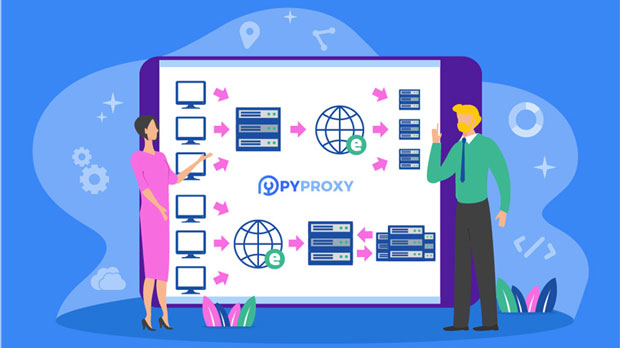In the modern digital landscape, businesses are constantly exploring ways to enhance their online presence, ensure data security, and access global markets. One of the most effective tools for achieving these objectives is the use of residential ip proxy services. residential proxies enable businesses to route their internet traffic through real residential IP addresses, offering a range of benefits including enhanced anonymity, bypassing geographical restrictions, and safeguarding against online threats. This article will delve into the reasons why enterprises need to consider long-term usage of residential ip proxy services, highlighting their importance for privacy, operational efficiency, and strategic advantage. 1. Improved Data Security and PrivacyA primary concern for businesses operating online is the security and privacy of sensitive data. Residential ip proxies offer enhanced protection compared to standard proxies or data center proxies, as they appear as genuine users accessing the internet from various locations. This makes it harder for malicious actors to track or intercept company operations. By utilizing residential proxies, businesses can ensure their sensitive data, such as customer information, payment details, and internal communications, remains secure.Additionally, using residential IP addresses helps businesses avoid detection by websites that might flag or block traffic from known data centers. This is particularly crucial for operations that involve web scraping or automation, where avoiding bans or IP blacklisting is essential. Residential IP proxies make it more challenging for websites to recognize the traffic as automated, thus ensuring seamless data collection.2. Access to Geo-Restricted ContentGeographical restrictions on content are a common issue businesses face when trying to access global markets or analyze competitive landscapes. Whether it's accessing region-specific advertising data, market trends, or local competitors’ websites, businesses often find themselves restricted by geo-blocking measures.Residential IP proxies allow enterprises to bypass these geographic limitations by providing IP addresses from various regions. This enables businesses to simulate local access, gather region-specific data, and test how their services or content will perform in different markets. For instance, companies can use residential proxies to test the effectiveness of localized advertising campaigns, ensuring they resonate with regional audiences without the risk of being blocked by regional IP restrictions.3. Enhanced Web Scraping and Market ResearchWeb scraping is a powerful tool for gathering large amounts of data from various online sources. For businesses, this could involve collecting competitive pricing information, tracking market trends, or gathering customer sentiment from social media platforms and review sites. However, without the use of residential proxies, web scraping can lead to issues like IP blocking, CAPTCHA challenges, or rate limiting from websites that detect automated activity.Residential IP proxies solve these problems by providing a vast pool of IP addresses that appear as normal users from different locations, thus avoiding detection. This means businesses can conduct large-scale web scraping activities without facing the usual barriers, ensuring a continuous flow of up-to-date information for strategic decision-making.4. Bypassing IP Restrictions and Rate LimitingMany websites impose IP-based restrictions or rate limits to prevent overloading their servers or to protect against bots. For businesses that need to access a large volume of data from these websites, hitting these limits can be detrimental. Residential IP proxies help mitigate this challenge by rotating IP addresses, ensuring that each request appears to come from a different source.This is particularly beneficial for businesses involved in SEO analysis, social media marketing, and competitive research, where frequent requests to the same websites are necessary. By using residential IP proxies, enterprises can avoid being blocked or rate-limited, ensuring smooth, uninterrupted access to valuable data sources.5. Protection Against DDoS AttacksDistributed Denial of Service (DDoS) attacks are a common threat to businesses operating online. These attacks can overwhelm servers, rendering websites or services unavailable. Residential IP proxies offer an extra layer of protection by distributing traffic across a network of real residential IPs, making it more difficult for attackers to target and block specific addresses.By leveraging residential proxies, businesses can ensure their services remain operational even in the face of DDoS attacks. This is particularly important for businesses that rely on high availability, such as e-commerce websites, financial institutions, or SaaS providers. In such cases, using residential IP proxies can help maintain the integrity of their services and protect their reputation.6. Cost Efficiency in Ad Verification and Fraud PreventionOnline advertising is a critical aspect of many businesses' marketing strategies. However, it is susceptible to fraud, with malicious actors using click farms, bots, or other fraudulent methods to inflate ad performance metrics. Ad verification services help businesses ensure that their advertising campaigns are legitimate and reach real users, but these services often require access to a wide range of IP addresses to monitor ad performance across various regions and platforms.Residential IP proxies are ideal for this task because they provide genuine, localized IP addresses that help verify the authenticity of ads and ensure that businesses are not paying for fraudulent clicks or impressions. By using residential proxies, businesses can monitor their ads in real-time, track fraudulent activity, and adjust their campaigns accordingly, improving overall ad spend efficiency.7. Scaling Operations with Minimal RiskAs businesses grow, they often need to scale their online operations to accommodate larger volumes of traffic, transactions, or customer interactions. Residential IP proxies allow businesses to scale their operations without the risk of being flagged or blocked by websites due to increased activity.Whether it's automating account creation, conducting price comparison, or scaling customer support services, residential proxies provide a flexible solution that allows businesses to grow their operations without encountering the usual restrictions imposed by websites. This scalability is crucial for businesses aiming to expand their market presence, conduct large-scale campaigns, or enhance their digital customer engagement strategies.8. Improving Customer Experience and PersonalizationResidential IP proxies can also enhance the customer experience by enabling businesses to test different website versions or services tailored to specific regions. By simulating traffic from different geographic locations, businesses can evaluate how their websites, content, or services perform across various markets, ensuring that they meet local preferences and needs.Moreover, residential proxies help businesses provide personalized content, offers, or advertisements based on regional user behavior. This targeted approach not only increases customer satisfaction but also improves conversion rates and loyalty. Personalization has become an essential component of modern business strategies, and residential proxies play a key role in enabling businesses to implement it effectively.The use of residential IP proxies offers a wide range of benefits for businesses operating in today's competitive digital environment. From ensuring privacy and security to accessing geo-restricted content and conducting large-scale web scraping, residential proxies are a valuable tool for enterprises looking to maintain a competitive edge. By investing in long-term residential IP proxy services, businesses can scale their operations, protect sensitive data, and enhance customer engagement, all while minimizing the risks associated with online operations. For companies looking to stay ahead of the curve, the adoption of residential proxies is no longer optional but a necessity.
Sep 16, 2025






















































